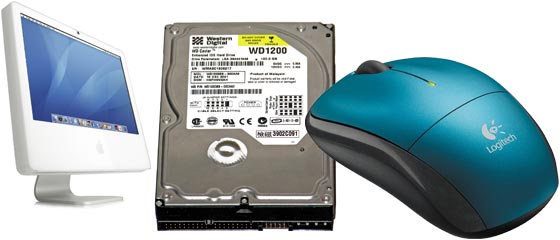 ![[Header]](../XuShared2/Line3.jpeg)

Add a Comment (Go Up to OJB's Blog Page) 50 Years ProgressEntry 1096, on 2009-10-07 at 10:27:30 (Rating 2, Computers) A couple of events this week lead me to reflect on progress in computer technology. The first was an article (I think on Slashdot) about the IBM 1401 Data Processing System, a computer system introduced in 1959; and the second was some fun (not) I had installing software on a PC running Windows - yes, I am just being facetious there but the more I use PCs the more I want to go back to my Mac!
So the System 1401 was no doubt a fairly awesome system at the time and it was only withdrawn in 1971. I think 12 years isn't a bad lifetime for a computer product. I couldn't find the physical dimensions or weight of this beast anywhere but it looks like it would weigh at least a tonne and use up several cubic meters of space. So what sort of performance did the 1401 provide?
It was available with 1400, 2000 or 4000 "positions" of core storage (the equivalent of modern RAM memory). I'm not sure how big a position actually was but if it was a byte that gives us about 1 to 4 K of RAM, about one million times less than the laptop I'm writing this on.
What about processing speed? The processing unit could handle 193,300 eight digit additions or 25,000 six digit by 4 digit multiplications per minute. When you specify the speed of a computer using what it does in a minute you know you're in trouble! My laptop would have about a million times the speed plus the ability to process much bigger numbers, do far more complex maths, plus do video and other media processing.
The 1401 used a card reader which could read 800 characters (bytes) per minute. Most hard disks can read millions of times faster than this so the improvement in speed is maintained in I/O as well.
Here's a description of the printer: "The printer incorporates a swiftly moving horizontal chain (similar in appearance to a bicycle chain) of engraved type faces, operated by 132 electronically-timed hammers spaced along the printing line." Sounds nasty. I wouldn't want to stick my fingers anywhere near the business end of that sucker!
As I said above, I expect the mighty beast weighed a ton and my laptop weighs a couple of kilograms so we haven't quite reduced the weight by the same factor but still that's a worthwhile weight saving, I think.
It seems that 50 years has given us a million times better computers which is a really impressive achievement. Many people would say that other technologies progressed by similar amounts in their early stages of development but I don't think that's really true.
TV is a similar age to computing and, although its improved a lot, it hasn't improved by a factor of a million. To do that we would now need TVs with 300 billion pixels instead of just 3 million in current high definition sets. Having to watch an old standard definition CRT TV after watching my plasma or LCD screen is pretty painful but the improvement isn't that great.
Another comparison could be cars. I currently have cars produced in 1981, 1991, 1998 and 2009 (yes too many - I need to sell one) and the improvement is noticeable even though I would have to say my favourite is still the 1991 Honda Prelude VTEC although the 2009 Suzuki Swift Sport is pretty nice too. Going from the 1981 Ford Laser to the 2009 Swift and you notice a big improvement, but to gain by a factor of a million the Swift would need to do about 140 million kilometers per hour and accelerate to 100 ks in a few microseconds. That would be fun!
Its easy to make fun of old computers but I think we should admire what they could do using quite primitive components. Transistors and integrated circuits can pack more logic into a space the size of a pin head than the 1401 had in all its massive cabinets, so its amazing that the IBM engineers could produce a system which worked reliably at all.
Its sort of like a quote one of my geeky friends likes to use: "the essential uselessness of [insert name of technology here] is disguised by the sense of wonder we feel because of the fact that it works at all!"
 There are no comments for this entry. 
You can leave comments about this entry using this form. To add a comment: enter a name and email (both optional), type the number shown above, enter a comment, then click Add.
Note that you can leave the name blank if you want to remain anonymous.
Enter your email address to receive notifications of replies and updates to this entry.
The comment should appear immediately because the authorisation system is currently inactive.
![[Comments]](../XuShared/Comment1B.jpeg) ![[Preview]](../XuShared/Comment6B.jpeg) ![[Blog]](../XuShared/Up2B.jpeg)
|

![[Comments]](../XuShared/Comment1B.jpeg)
![[Preview]](../XuShared/Comment6B.jpeg)
![[Blog]](../XuShared/Up2B.jpeg)